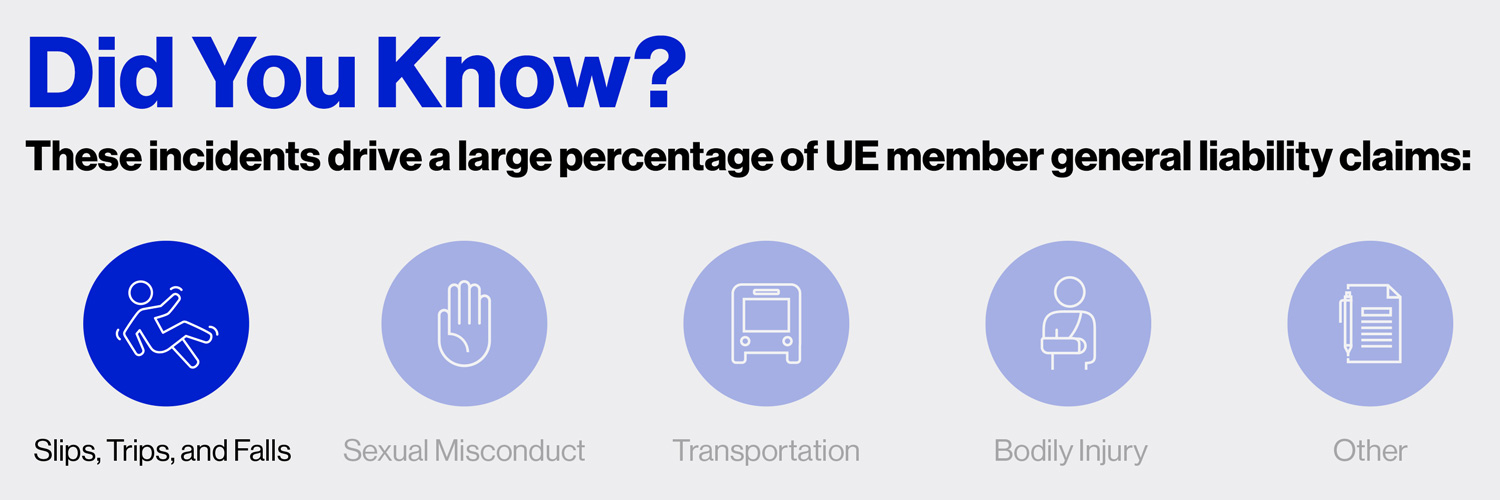University of Maine System Uses Online Forms to Address Slips, Falls Faster

A technology update has helped the University of Maine system improve the response time for preventing slip-and-fall risks and — anecdotally, at least — has helped raise awareness that the university is concerned about student and faculty safety.
As recently as February 2020, when students or employees wanted to report a slip, trip, or fall on a University of Maine campus (there are seven campuses from southern Maine to near the Canadian border), they needed to fill out a paper form and fax it to the university system’s Risk Management department.

Sometimes people got discouraged by the process. Fax machines can be hard to find. Faxes didn’t always go through or arrived days after an incident occurred. Sometimes, rather than faxing, people would hand write their fall details, scan in information, and email it to Risk Management. In some cases, the university didn’t know for days that the on-campus injury risk existed.
Gretchen Catlin, the system’s Director of Risk Management and Real Estate, proposed creating an online tool that could be accessible everywhere for anyone to submit a report. The university already has seen benefits of having students and employees have access to the user-friendly tool.
“We can’t be everywhere, so we’re relying on each campus to be our eyes and our ears and to help us help them prevent these injuries,” Catlin says.
With the tool on the system’s internal portal, the risk of losing a report is gone. People who fill out forms online automatically receive a response that gives them a ticket number for tracking. Tickets also allow the university system to track reports and response, and ticketing helps the system “track workloads within our department as well.”
One person at a university campus fell on ice when walking between buildings. The person quickly filled out an online slip-and-fall report and within 20 minutes a facilities employee was de-icing that sidewalk.
“It definitely helps us with quick response times,” Catlin says.
Tool Shows That the University Cares
One change between the old paper form and the new online form has had a particularly major impact.
The form now asks the person how they would have solved the injury risk, possibly preventing the fall from happening. Before, there wasn’t a question about injury prevention — the university didn’t ask people if they had other feedback they’d like to share with the university.
And now when someone fills out the form online, the university replies, thanks the person for reporting the incident and lets them know the problem has been addressed.
“The follow-through and the closure, we thought, was important,” Catlin says.
Because the online form hasn’t been in place for long, it’s too early to see if it and the increased engagement will lead to a reduction in claims filed against the institution.
But it clearly has helped with student and employee safety.
In one incident where a person fell on stairs inside a building, the facility’s Director, who filled out the online form, recommended the university place tape at the end of each stair so that the stairs are more visible. The university took that action.
Another employee who filled out a form wrote that her fall outside occurred due to her clumsiness. The university followed up, trying to drill down what could be done to improve safety. She noted that she was wearing high heels when she fell. Risk management suggested that this time of year, she could keep her high heels in her office but wear different shoes when walking through campus.
Online Tool Helps With Workers’ Comp, Too
As part of its workers’ compensation insurance, the university system must send in claims to the state within seven to 10 days of a slip-and-fall injury (or face financial penalties if claims are filed later than that). With the requirement of a faxed form, often it would take days for reports to be reach the right people.
Now about 90% of the university’s reports from students or staff are filled out online within the initial 24-hour period after a fall.
“That’s a vast improvement,” Catlin says.
Return to Campus Should Impact Falls This Year
During the 2020-21 school year, the pandemic led to a significant decrease in the presence of people on campus and the university saw, as expected, a significant decline in the number of injuries caused by slips, trips, and falls. However, thanks to the form, the university did see an increase in the reporting of slips, trips, and falls, Catlin says.
Taking those two points together, Catlin says, it’s clear that more people became aware of and used the online tool.
This should increase as well as the university system’s Risk Management department works closely with each campus to build positive rapport and let employees know that the form is meant to allow campuses to proactively respond to injury risks and is not punitive.
More Strategies to Reduce Falls
Based on Maine’s experiences, Catlin recommends institutions consider these additional strategies when addressing slips, trips, and falls:
Post Warnings Throughout Your Campus
Each season over the past few years, the University of Maine system has placed eye-catching posters on doors across its campuses to raise awareness of slips, trips, and falls.
The posters’ images change seasonally, but the messages are generally the same. They center on Surface, Awareness, Footwear, and Environment (SAFE) issues.
For example, the posters encourage people to consider changes in surfaces as they encounter changing levels or steps. They also invite people to consider whether they’re wearing appropriate footwear given the outdoor conditions.
“We have a motto in Risk Management — Slow down to speed up!” Catlin says. “The SAFE acronym is a great example of this. Pay attention to your surroundings, take your time, and you can arrive safely.”
It’s important to change posters frequently because their effectiveness diminishes the longer a poster is in place.
Ensure Employees at Highest Risk Wear Proper Footgear
A data analysis showed that the University of Maine’s facility workers and police employees are at greatest risk for slips, trips, and falls. As a result, the university’s Risk Management department is supplying those employees Geroline K1 Mid-Sole Ice Cleats.
Employees can place the cleats on regular shoes or boots. The cleats can be rotated up when the employee is indoors and rotated toward the ground when the employee is outside so the employee has greater traction.
The university system doesn’t have specific data about cleat effectiveness, as they just distributed the cleats to employees in December 2021. The university is working with its carrier for workers’ compensation insurance and with affected university departments to gather feedback about the effectiveness.
Initial feedback indicates that because the cleats can easily be placed on and taken off, compliance in cleat wearing is likely to be higher than in the past. Feedback was that cleats provided by individual departments in the past were cumbersome and not easy to put on. Cleats were easily forgotten in desks or in cars.
Provide Staff Education, Training
The University of Maine system requires safety training for new hires and annually for current employees.
UE offers new online courses for higher ed institutions on Slips, Trips, and Falls.
- Slips, Trips, and Falls: A Balancing Act is a 20-minute course that helps faculty and staff identify hazards and describe strategies for avoiding hazards.
- Preventing Slips, Trips, and Falls: Keeping Your Campus Safe is a 40-minute course for facilities, buildings, and grounds staff and supervisors. In addition to helping them identify hazards, it helps them understand common techniques for addressing hazards and helps them recall safe practices when responding to hazards or implementing preventive measures.
In addition to safety training it offers, the University of Maine’s system encourages managers and directors of each department to speak with staff about prevention strategies for slips, trips, and falls.
“The more people are part of the solution, the better off we’ll be in terms of implementing the solution,” Catlin says.





